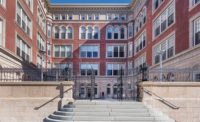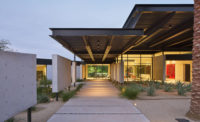In a dense residential area of the South Korean city of Gimpo, just west of Seoul, a church’s sculptural form breaks up the surrounding cityscape of banal apartment towers. Seoul-based IDMM Architects designed the reinforced-concrete structure— defined by stacked volumes, shadow-filled crevices, and a variety of apertures—to maximize its multifaceted program on a compact site. It is “a space between contemporary spiritual practice and everyday urban life,” says principal Heesoo Kwak. Named to highlight its ecumenical practice, the seven-story building contains a main chapel with bleacher seating that spans from the second to fifth levels. Above and below this space, the architects placed a lobby, community room, two secondary chapels, and offices on top of one another like pieces of a 3-D jigsaw puzzle. The client, the Presbyterian Church of Korea, hoped not to offend the sensibilities of local residents, who subscribe to a range of beliefs, so asked for modest religious references. The shape of a cross, delicately carved out of the facade and illuminated at night, distinguishes the building’s function with a “humble voice,” says the architect. An exterior stair zigzags up to the rooftop—which can be used for worship services as well as community functions—evoking a sense of movement. The overall result of the design, says Kwak, is a “harmonized place” without the “strong color of religion.”
The Closest Church by IDMM Architects
Gimpo, South Korea

The Closest Church, designed by Seoul-based IDMM Architects, sits on the edge of a major thoroughfare in a residential area of Gimpo, South Korea.
Photo © Kyungsub Shin

The reinforced concrete structure takes on an irregular form defined by stacked volumes, sharp edges, and shadow-filled crevices.
Photo © Kyungsub Shin

A stair that zigzags up to the rooftop is a prominent feature of the building’s exterior.
Photo © Kyungsub Shin

A rooftop space is used for worship services as well as community functions.
Photo © Kyungsub Shin

Photo © Kyungsub Shin





Post a comment to this article
Report Abusive Comment